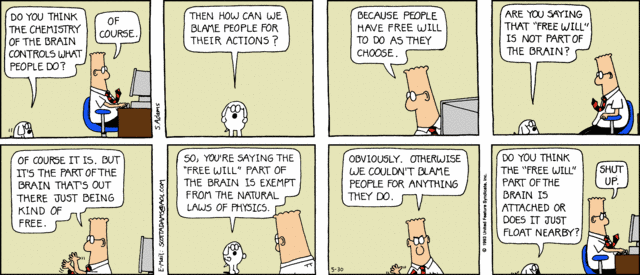I have been seeing an uptick in press releases and marketing hype from HR Tech vendors — cough — AI powered, Machine Learning, Predictive Analytics, Innovative and Disruptive, blah blah blah, claiming to predict employee attrition, and have been wondering if HR leaders really believe this marketing hype? What is the difference between a person being 20%, or 70%, or 90% likely to leave? And what if there were 10 people who are 70% likely to leave, does that mean that 7 of them will leave, 3, 0, or all 10? And if 7, then exactly which 7?
If organizations blindy buy into this nonsense then we’re really a lot closer to living out the fantasy portrayed in the Tom Cruise-starring movie Minority Report, and its enigmatic Pre-crime (or precrime) unit, which is a specialized police department that apprehends criminals before they commit any said crime, based on foreknowledge provided by three psychics called “precogs”. Precrime is a term coined by science fiction author Philip K. Dick. Precrime intervenes to punish, disrupt, incapacitate or restrict those deemed to embody future crime threats. The term precrime embodies a temporal paradox, suggesting both that a crime has not occurred and that the crime that has not occurred is a foregone conclusion. Does HR really want to become a 2020 corporate version of Precrime?
If the so-called HR Tech precog vendors’ technology actually worked, we’d then have a moral conundrum on our hands that would likely escalate to the Supreme Court because we’d be debating determinism vs. free will. But all you have to do is take a step back and ask some basic questions to quickly realize that beyond the intellectual curiosity of performing a “big brain” calculation, the HR Tech precogs’ outcome actually prescribes nothing that’s actionable.

What is a person who is 83.7% likely to leave? A decision to leave is binary. Anyone who has ever changed jobs didn’t have an app that helped them calculate the statistical probability of them leaving [although now thinking about it, that might actually be a cool idea]. And if you are labeled by the HR Tech precog as an 83.7% job changer, does that mean you only work 16.3% of your time at your current job and 83.7% of the time looking for a new job?
Changing jobs is binary; you either change jobs or you stay in your current job. I am immediately reminded of a cute riddle my former boss (CEO) told me. He was a retired Brigadier General, and full of colorful parables that taught me things in life and business. “Beygelman,” he always yelled at me, “There are five frogs sitting on a log. Four decide to jump off. How many are left?” What’s your answer? Take your time. No rush. Take a moment to consider your answer. How many are left? The answer will come later or you might have already solved the riddle.
2020’s HR Tech’s precogs — too many to mention by brand name — will now miraculously look into their crystal ball to tell you who will leave your company and who will not leave, but wait, they’ll only do it with 72.4% accuracy! But what does that even mean? And how do you as an HR leader even begin to action anything based on this information? Today’s HR Tech precogs will — analogously — tell you that their algorithms have determined that 44.25 miles per hour is absolutely too fast to drive, maybe even fatal, but without telling you if the speed limit is 30 mph or 75 mph. Did you know that the average speed for a fatal car accident in Iowa is only 21 mph, while in Georgia the average speed for fatal car crash is 70 mph?
Having a speedometer to tell you how fast you are driving, and allowing you to make a decision based on that information, could be a far better approach than having the car shut itself off because at 44.25 miles per hour you are XX% more likely to get into a fatal car accident — in Arizona. Admittedly, I am passionate about this topic because I started a workforce analytics company called Claro Analytics, and one of the more interesting features of our technology is a feature that measures job seeking activities — like a speedometer — but we dare not venture into Minority Report precog land to suggest to you that employee X or employee Y is 68.4% likely to leave. That just reeks of determinism and creates a negative perception about a specific employee based on an HR Tech precog’s prediction that you are 68.4% destined to leave.
Not only does AI for recruiting and retention have a well-documented bias problem, most of the early leaders in this area have already shut down their programs for reasons like sexist results and other biases. The reality is that the nonsensical AI Hype Cycle is already over but the incessant onslaught of HR Tech precog vendors don’t want you to know that. Imagine discriminating against a person because a HR Tech precog vendor’s technology told you that one of your employees is 81.4% likely to quit? Subconsciously [and most likely unintentionally] you or your organization might treat that person differently and then the person quits. Thereafter you perform your analysis and say, “wow, the HR Tech vendor precogs are right, these people do actually quit,” but now you are also using “resulting” to make future decisions; you have officially started down a very slippery slope that you are best to avoid.
By the way, the answer to the riddle, in case you forgot about it, is five. The reason being is that deciding to do something and doing it are two very different things. We think that observing and understanding someone’s job-seeking behavior — did the frog jump or did it not jump — measuring that action, and having factual longitudinal data about that action, is a much better approach than relying on HR Tech precogs telling us how likely one of the four frogs are to jump based on their AI-powered, Machine Learning algorithms.
